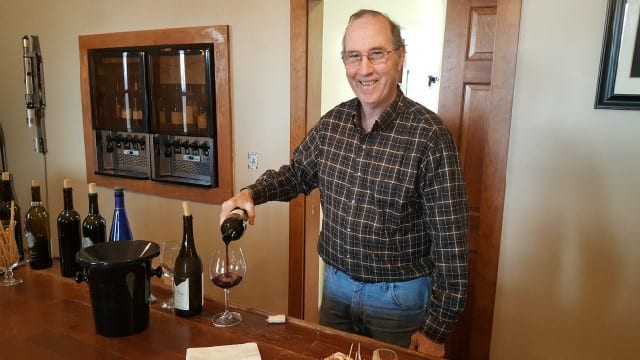
07 Mar The West Side of the Blue Ridge Mountains: The Shenandoah Valley and Cave Ridge Vineyards
This story originally appeared in the Napa Valley Register.
The Shenandoah Valley sits between two mountain ranges, the Blue Ridge Mountains and the Allegheny Mountains.
Tucked in a valley, it does not have close proximity to urban centers as its neighboring wine regions (Middleburg AVA has Washington, D.C., and Monticello AVA has Charlottesville). What the Shenandoah Valley has is the town of Winchester to the north, which is the apple capital of the country, and the small town of Staunton to the south, a charming place.
In addition, the Shenandoah Valley is located at a higher elevation and gets less rain compared to the east side of the Blue Ridge Mountains and other wine areas in Virginia. It is a statistically drier and cooler area, and perhaps it is the most ideal place to be making wine in Virginia.
After flying across the country to Washington, D.C. and then driving two hours to Charlottesville last week, I arrived at my friends’ house where I was staying. They opened a bottle of Glen Manor 2013 Cabernet Franc to enjoy with dinner.

I was more than happily surprised by this gorgeous, soft red wine with notes of ripe blackberries, cassis and brown spices, round tannins and a touch of acidity. This wine was from the western slope of the Blue Ridge Mountains in the Shenandoah Valley, from vines planted in steep rocky soils that site between 1,100 and 1,300 feet above sea level. This was my first introduction to the wines of the Shenandoah Valley and it was quite a good start.
There are approximately two dozen wineries located in the valley, including Cave Ridge Vineyards. From the top of the hill, at the entrance of the wine tasting room, you can look down the vineyard and see the Allegheny Mountains to the left (west) and the Blue Ridge Mountains to the right (east).

Allegheny Mountains (on left) & Blue Ridge Mountains (on right)
Owner Randy Phillips purchased the property in 2000 and planted from 2002 to 2004. The soils are well-draining limestone, sandstone and ancient sea sediment. With good air flow coming from the west, the vineyard has never suffered from a big frost.
Phillips’ background in in agriculture. He worked in citrus in Florida and with cattle in Northern California and oversaw agricultural policy at the USDA. While he still consults with county governments on environmental issues, Phillips wanted to make wine and researched areas in which to grow grapes.
What drew him to the Shenandoah Valley is that it is the driest climate east of the Mississippi. The Blue Ridge Mountains block the cold from the east and there is an inversion layer that sits over the vineyard. Phillips has 13 acres planted on his property and owns another 12 acres approximately 15 minutes away. While Cave Ridge Vineyards is somewhat isolated, Phillips picked the area for its quality.
I spent a lovely afternoon at Cave Ridge with Phillips where I had the opportunity to do a vertical tasting of his cabernet franc. Tasting seven vintages, ranging from 2005-2013, I could get a sense of the evolution of Cave Ridge Vineyards and the influence of each vintage.
Cave Ridge Vineyard Cabernet Franc 2005 – The vines were only two years old when this wine was first made. The wine has aromas of black raspberry, licorice and cured meat but also some pyrazine (green pepper, herbaceous) notes.
Cave Ridge Vineyard “Red Silk” Barrel Select Cabernet Franc 2007, – This is the vintage that was considered the best for Virginia. It was a perfect year, with a hot August and little rain in September, resulting in a wine with dark red fruit, brown spices and a velvety mouthfeel. In the years that Phillips deems the best, he calls the cabernet franc “Red Silk” and this was the first vintage to get that label.
Cave Ridge Vineyard Cabernet Franc 2008 – An average year, there was a little rain in August and September. The resulting wine has notes of stewed fruit and blueberry.
Cave Ridge Vineyard “Red Silk” Barrel Select Cabernet Franc 2010, – Another good growing season, the 2010 has notes of dried cherry and black fruit and a hint of pyrazine.
Cave Ridge Vineyard Cabernet Franc 2011 – 2011 was a tough vintage for Virginia with a hurricane and tropical storm but less so in the Shenandoah Valley. While Northern Virginia got six inches of rain, the valley only got two inches. Fortunately, August was dry. Phillips called this vintage a “huge learning experience” and the resulting wine has red fruit and brown spice aromas.
Cave Ridge Vineyard Cabernet Franc 2012 – While September was dry in 2012, there was rain in August, and August is the month that determines what the vintage will be like. This wine has a hint of pyrazine, as well as aromas of sweet brown spices, licorice and blackberry. On the palate it has medium acid and medium tannins.
Cave Ridge Vineyard “Red Silk” Barrel Select Cabernet Franc 2013 – 2013 turned out to be a better year than Phillips thought it would be. The wine has notes of dried black fruit and dark red fruit. There is a spiciness on the finish. It is still a young wine and will be even better in a few more years.
To Phillips, the Shenandoah Valley is the perfect place to make wine. And, what he has learned over the years is that if he manages the vineyard correctly, including meticulously touching each vine approximately eight times each year, some of Mother Nature’s events do not pose as big a threat to the vintage.
Read the original story in the Napa Valley Register.
Discover more from Please The Palate
Subscribe to get the latest posts sent to your email.





